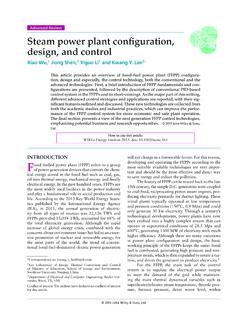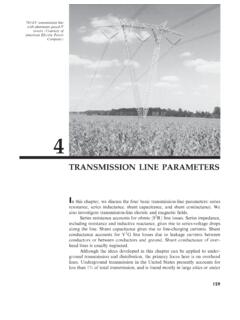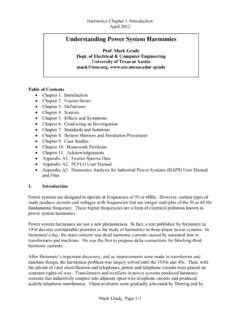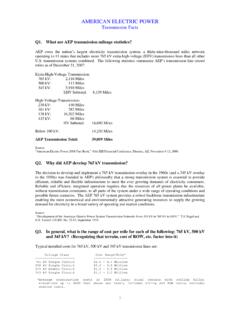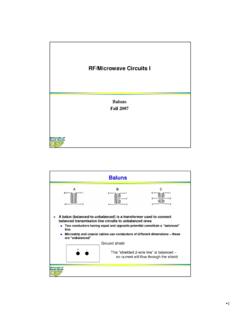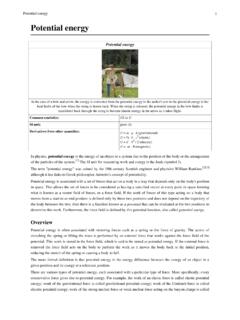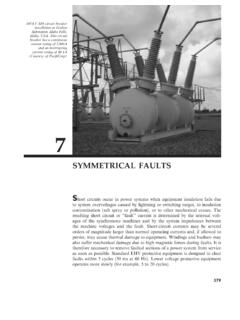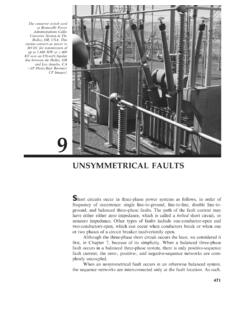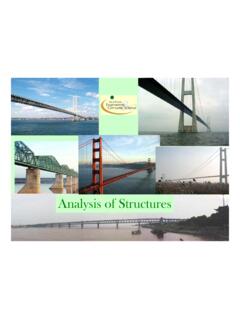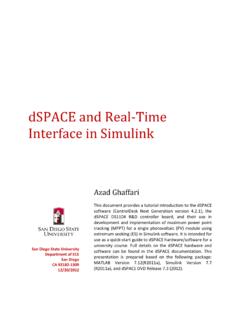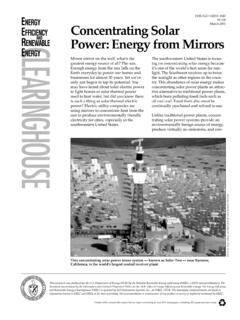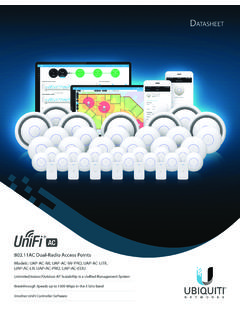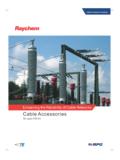Transcription of Steam power plant configuration, design, and control
1 Advanced ReviewSteam power plant configuration, design, and controlXiao Wu,1 Jiong Shen,1 Yiguo Li1and Kwang Y. Lee2 This article provides an overview of fossil-fuel power plant (FFPP) configura-tion, design and especially, the control technology, both the conventional and theadvanced technologies. First, a brief introduction of FFPP fundamentals and con-figurations are presented, followed by the description of conventional PID-basedcontrol system in the FFPPs and its short-comings. As the major part of this writing,different advanced control strategies and applications are reported, with their sig-nificant features outlined and discussed. These new technologies are collected fromboth the academic studies and industrial practices, which can improve the perfor-mance of the FFPP control system for more economic and safe plant final section presents a view of the next generation FFPP control technologies,emphasizing potential business and research opportunities.
2 2015 John Wiley & Sons, :WIREs Energy Environ2015. doi: fuelled power plant (FFPP) refers to a groupof power generation devices that convert the chem-ical energy stored in the fossil fuel such as coal, gas,oil into thermal energy, mechanical energy and finallyelectrical energy. In the past hundred years, FFPPs arethe most widely used facilities in the power industryand play a fundamental role in social production andlife. According to the 2013 Key World Energy Statis-tics published by the International Energy Agency(IEA), in 2011, the annual generation of electric-ity from all types of sources was 22,126 TWh andFFPPs provided 15,054 TWh, accounted for 68% ofthe total electricity generation. Although the rapidincrease of global energy crisis, combined with theconcerns about environment issues has led to an exten-sive promotion of nuclear and renewable energy, forthe most parts of the world, the trend of conven-tional fossil-fuel-dominated electric power generation Correspondence to: Laboratory of Energy Thermal Conversion and Controlof Ministry of Education, School of Energy and Environment,Southeast University, Nanjing, China2 Department of Electrical and Computer Engineering, Baylor Uni-versity, Waco, TX, USAC onflict of interest: The authors have declared no conflicts of interestfor this not change in a foreseeable future.
3 For this reason,developing and operating the FFPPs according to themost suitable available technologies are very impor-tant and should be the most effective and direct wayto save energy and reduce the history of FFPP can be traced back to the late19th century, the simple generators were coupledto coal-fired, reciprocating piston Steam engines, pro-ducing electricity primarily for district lighting. Theseinitial plants typically operated at low temperatureand pressure conditions (150 C, Mpa) and couldonly generate 30 kw electricity. Through a century stechnological developments, power plants have nowbeen evolved into a highly complex system that canoperate at supercritical conditions of Mpa and600 C, generating 1300 MW of electricity with muchhigher efficiency.
4 Although there are many variationsin power plant configuration and design, the basicworking principle of the FFPPs keeps the same: fossilfuel is combusted, generating high pressure and tem-perature Steam , which is then expanded to rotate a tur-bine, and drives the generator to produce the FFPP, the main task of the controlsystem is to regulate the electrical power outputto meet the demand of the grid while maintain-ing the main thermal dynamical variables such assuperheater/reheater Steam temperature, throttle pres-sure, furnace pressure, drum water level, within 2015 John Wiley &Sons, tolerances to keep the power plant operatingsafely. Generally, such an objective is achieved viathe multi-loop proportional-integral-derivative (PID)based controllers.
5 The approach has been proven tobe highly reliable and can attain a satisfactory per-formance under normal operation maintained at baseload, where plant characteristics become almost , during the past few decades, powerindustry has undergone some significant changes,and as the primary devices of power production,FFPPs have been endowed with higher growth of electric power demand increasesthe magnitude of the cyclic variation of the gridload, and the renewable sources, such as wind,solar and hydro power , are severely influencedby the season and the weather condition; thus,the FFPPs have to participate in the grid powerregulation frequently and respond to the loaddemand variation quickly within a wide oper-ation privatization and deregulation of theelectricity industry has changed the power gen-eration business from a cost-plus, monopolyenvironment with an obligation to serve, toa competitive environment for the sale of itsproduct.
6 For this reason, power plants areincreasing in size and becoming more complexin order to achieve high efficiency and the scaleof economy. Furthermore, the aforementionedthermal parameters should be more stringentlycontrolled so that the plant can operate in anoptimal mode at all , control problems to deal with issues,such as nonlinearity over a wide operation range, largeinertial and time varying behavior, and strong cou-pling among the multitude of variables, become severein the FFPPs. Consequently, the conventional PI/PIDbased controllers are no longer sufficient in meetingperformance specifications, even if they are well tunedat a given load level. On the other hand, with the helpof modern computer and instrumentation techniques,utilizing Distributed control System (DCS) is now theroutine rather than the exception, which makes theimplementation of advanced controllers possible inthe FFPPs.
7 The primary purpose of this writing is topresent an updated, representative snapshot of vari-ous control strategies that are being applied to theFFPPs and describe how they can help in improvingthe quality and performance of plant operation. Theinformation reported here are collected from both aca-demic researches and engineering brief introduction of FFPP fundamentals andconfigurations are presented first, followed by thedescription of conventional PID-based control systemin the FFPPs and the associated problems. As amajor part of this writing, different advanced controlstrategies and applications are reported, with theirsignificant features outlined and discussed. The finalsection presents a view of the next generation FFPP control technologies, emphasizing potential businessand research CONFIGURATION AND DESIGNThe essence of power production process in all types ofthe FFPPs is energy conversion.
8 In the vast majority ofthe FFPPs worldwide, water/ Steam is commonly usedas the working fluid, which is alternately vaporizedand condensed in a closed circuit following a thermaldynamic cycle. Within this cycle, the chemical energyof the fossil fuel is transformed into Steam thermalenergy by the boiler, then it is transformed intorotational mechanical energy by the turbine, andfinally it is transformed into electric energy by thegenerator. This kind of FFPPs is also called steampower plant , and depending on the operating steampressure, it can be classified into subcritical plants andsupercritical Steam PlantIn subcritical power plants, the Steam parame-ters never exceed the critical point: Mpa, C. Because under this critical point, liquidwater must go through a vaporization stage to becomesteam; in most of the large-scale subcritical plants,drums are typically utilized to separate the Steam outof the 1 provides a simplified illustration of acoal-fired subcritical power plant , which is comprisedof two basic systems: the fuel/air-flue gas system andthe water- Steam 4 The fuel/air-flue gas system is also called the fire-side of the plant .
9 In this system, the raw coal is trans-ported to the coal hopper by the conveyor and entersthe pulverizing mill; where grinding and crushing takeplace. The qualified (smaller and lighter) coal parti-cles are then separated and entrained in the air flow,and carried into the burner. Finally, the combustionoccurs in the furnace, generating high temperature(above 1000 C) flue gases. The air needed for com-bustion is delivered to the furnace and mill by theforced draught fans and an air preheater is installed in 2015 John Wiley &Sons, Energy and EnvironmentSteam power plant configuration, design, and controlKey1. Cooling tower8. Condenser15. Coal hopper22. Air intake2726252322211917142420181613151211 109651243872. Cooling water pump9. Intermediate pressure turbine16.
10 Pulverized fuel mill23. Economizer3. Pylon (termination tower)10. Steam governor17. Boiler drum24. Air preheater4. Unit transformer11. High pressure turbine18. Ash hopper25. Precipitator5. Generator12. Deaerator19. Superheater26. Induced draught fan6. Low pressure turbine13. Feed heater20. Forced draught fan27. Chimney stack7. Boiler feed pump14. Coal conveyor21. ReheaterFIGURE 1|Simplified coal-fired subcritical power plant (Picture from #Boiler_furnace_and_steam_drum).the path to warm the air being fed utilizing the heatremaining in the exhaust gases leaving the furnace,through which the efficiency of the combustion can beimproved. The objective of this process is convertingthe chemical energy in the fuel into the thermal energyin the flue gases.
